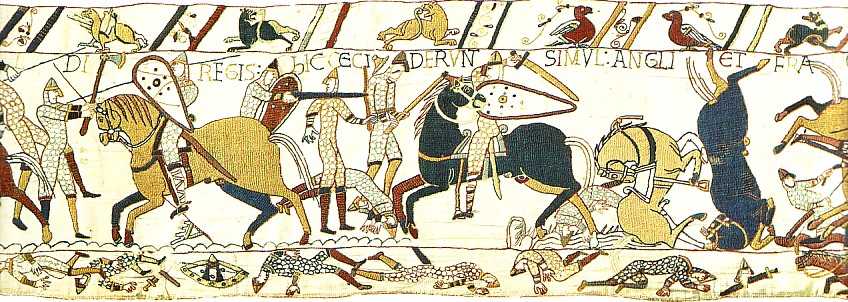
HERE...
Only two of these fifteen English warriors have the famed broadaxe of the housecarles. All the others are either throwing javelins (one "francesca") or thrusting with spears overarm.
The "raptors" - three of them - in the border above are looking menacingly down at the fighting. This may have held metaphorical significance to people of those times, and could indicate the impending feigned flight which proved so disastrous to the English side. (Certainly the carrion crow and raven and eagle hold sway over many a Scandinavian battlefield in the sagas.) For instance, in the upper border can be seen other fell birds in the scenes depicting Harold's capture, his being taken captive to William's palace; the quicksand scene, and the rallying scene when William takes off his helmet.
The lower margin is littered with mingled and dismembered slain. There is no way to determine which side the bodies belong to - unless we allow that the famed cutting power of the English broadaxe is reponsible for the severed body parts.
The right-facing English are back "in scale" with the mounted knights, indicating that now the attackers have come right up on the hill to engage in hand combat. The righthandmost housecarle is the only warrior in this group of fifteen actually using his broadaxe. His position is before the main body of his spear-armed companions: indicating that only a small proportion of the English line actively wielded the two-handed axe out in front of the main shield-wall, whilst being covered by the spears.
...LEOFWINE AND GYRTH HAVE FALLEN, THE BROTHERS OF...
Probably the multiplicity of dying figures in this violent scene is meant to depict how Harold's two brothers were vanquished. After receiving numerous attacks and being wounded, they finally toppled over in death. Javelins pierce and overarm thrusts or couched lance drive home over shield rim. Obviously Gyrth and Leofwin were killed during the mounted attack. Their bodies, according to Poitiers, were found after the battle near Harold's. If so, they were either in command with him of the housecarles massed in the center, or else their bodies were brought up to the hill during a lull in the fighting (of which there were at least several, if not many). The Carmen describes how Gyrth, over with the English left, killed William's horse with a javelin, and then the duke hewed him "limb from limb shouting: 'Take the crown you have earned from us!'" Apparently he confused the younger Godwinson in the heat of battle for his elder brother.
Not all of the casualties in the lower border are necessarily dead: a couple appear to be taking shelter under their large shields, the only expedient for any knight who is unhorsed during a cavalry attack: he waits until the hooves have gone beyond him and then gets up and retires to the rear if he can.
...KING HAROLD - HERE THE ENGLISH AND FRENCH HAVE FALLEN TOGETHER...
There is an unusual triangular standard that has fallen point downwards. As this scene is blended together with the next where the Normans/Bretons are obviously getting the worst of it, we are left to wonder if the standard is a fallen English or Norman one (it could belong to either, as Scandinavian influences were rife on both sides, and this banner resembles a viking war flag; all that is lacking is a raven motif). Beginning with the dismounted knight, after the word REGIS, and ending with the English last-stand on the hillock, this part of the Tapestry evokes a feeling of pure carnage and chaos. No one here knows what is going on, who is winning, or even who behind you is on your side. The dismounted knight, just mentioned, has missed his stroke and only succeeded in lopping off the axe head of a surprised housecarle who has just turned around. A bodiless head rolls at the feet of a beefy housecarle with a fine mustache who has just buried his axe head in the skull of a black charger (surely the detail here was meant to be funny in a grisly sort of way). Generally the disorganized English seem to be having the better of it at this point. This fits in with the Carmen account, and in a less forthright way Poitiers also: both describe the wings of William's army getting into difficulties and having the English wings counterattack down the hill.
The marshy ground (I do not think this detail is supposed to be an enstaked position, because of the clearly rendered wavy lines like the edges of a pond or stream -- today the area has more ponds but less marsh than in 1066) is clearly depicted at the base of the following hillock, showing graphically how far the English pursuit went - right into the marshes of the Asten brook. Horses tumble head over hooves: the vertical one is lacking a saddle: along with a lack of shields on all of the warriors, this is probably meant to focus attention to the dramatic posing of the stricken horses.
(for the foot figure at the extreme right, partially cut off by my scan, see the following page's description)




